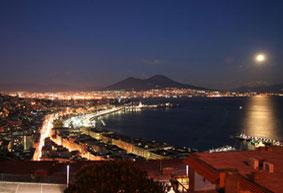


All the structures

Naples is a province much loved for its colours, traditions and contrasts. It is known worldwide for its culinary inventions and dialect. The entire historic centre of Naples has been declared a World Heritage site by UNESCO.
Among Naples most important squares are the Piazza del Municipio and the Piazza del Plebiscito, and a visit to the Church of San Giacomo degli Spagnoli should not be missed. Castel Nuovo, known as ‘Maschio Angioino’, is a record of the power of the House of Anjou, and later of the Houses of Aragon and Bourbon, all of whom ruled the city.
The eighteenth-century Palazzo Reale di Capodimonte overlooking Naples is a true architectural treasure. Worth visiting is the famous Via Toledo and the famous Neapolitan opera at Teatro San Carlo, also a UNESCO World Heritage building.
The province of Naples is renowned for its history, art and traditions, to be discovered on as slow a journey as possible. Pompeii is an ancient archaeological site of worldwide importance, known to all for the Ancient Roman city that was completely covered by the eruption of Vesuvius in 79 AD.
Herculaneum is another city famous for its many archaeological excavations; along with Pompeii and Torre it is also included among the World Heritage sites.
Readers of these pages are sure to be nature lovers and will find the province full of wonderful parks – Vesuvius is one. The environment around Vesuvius is the result of a great many eruptions, with vast areas rich in minerals carried by the lava and unique scenery that makes the area an unmissable destination for travellers.
A network of trails provides an entrance into this fascinating world: La Valle dell’Inferno, the Cognoli Trails, Monte Somma, the Tirone Reserve, Gran Cono, Strada Matrone, Vallone Della Profica, Trenini A Cremagliera and Fiume di Lava.